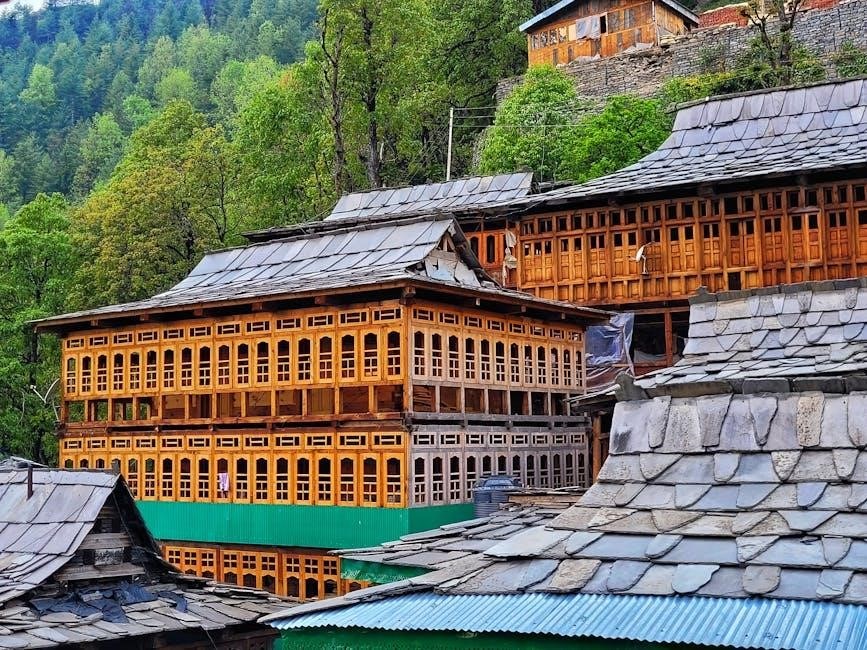physical features of india class 9 pdf
India’s diverse physical features include mountains, plains, plateaus, deserts, and islands, showcasing its geographical richness. These elements significantly influence climate, vegetation, and human activities, making their study crucial for understanding the nation’s ecosystems and cultural heritage.
Overview of India’s Geographical Diversity
India exhibits remarkable geographical diversity, with its vast landscape comprising towering mountain ranges, expansive plains, arid deserts, fertile plateaus, and coastal regions. The Himalayas, the world’s youngest and highest mountain range, dominate the north, while the Northern Plains, formed by river deposits, stretch across the Indo-Gangetic basin. The Peninsular Plateau, one of the oldest landforms, covers central and southern India, enriched with mineral resources. The Indian Desert in the northwest and the Coastal Plains along the eastern and western coasts add to the country’s varied topography. These diverse physical features not only shape India’s climate and ecosystems but also influence human settlement, agriculture, and cultural practices. Understanding this diversity is essential for appreciating India’s natural and cultural heritage, as each region contributes uniquely to the nation’s identity. This geographical richness makes India one of the most varied countries in the world.
Importance of Studying Physical Features
Studying India’s physical features is crucial for understanding its ecological balance and human activities. These features shape the climate, influencing agriculture, which is vital for the economy. They also determine natural resources, biodiversity, and cultural practices. By analyzing these elements, we can address environmental challenges and promote sustainable development. This knowledge aids in disaster management and conservation efforts, ensuring the preservation of ecosystems for future generations. Additionally, it helps in planning infrastructure and resource distribution, fostering economic growth. Understanding physical features is essential for combating climate change and ensuring sustainable development. This study provides insights into India’s natural and cultural heritage, highlighting the interconnectedness of its diverse landscapes. It is vital for students to grasp these concepts to appreciate the country’s complexity and contribute to its sustainable future. Thus, studying physical features is not just academic but also practical, offering solutions for real-world challenges.

The Himalayan Mountains
The Himalayas are young fold mountains with high peaks and deep valleys, formed by the collision of the Indian and Eurasian plates. They are vital for India’s climate and culture.
The Himadri: The Northernmost Range
The Himadri, or Great Himalayas, is the northernmost and highest range of the Himalayan Mountains. It is renowned for its towering peaks, including Mount Everest and K2, and glaciers like Siachen. This range is structurally the most stable part of the Himalayas, with granitic rocks forming its core. The Himadri acts as a climatic barrier, shielding the Indian subcontinent from cold Arctic winds and contributing to the monsoon rainfall. Its rugged terrain supports limited vegetation but is home to diverse flora and fauna adapted to extreme conditions. The Himadri also holds significant cultural and religious importance, with numerous sacred sites like the source of the Ganges River. Its peaks and valleys are a hub for adventure sports, attracting global explorers and trekkers annually. The range’s geological stability, despite tectonic activity, makes it a unique feature in India’s physical landscape.

Lesser Himalayas: Mid-Himalayan Ranges
The Lesser Himalayas, also known as the Himachal, form the middle section of the Himalayan ranges. Situated south of the Great Himalayas (Himadri), this range is lower in elevation, with an average height of 3,500 to 4,500 meters. It includes prominent peaks such as the Dhauladhar and Pir Panjal ranges. The Lesser Himalayas are characterized by densely forested slopes, fertile valleys, and significant rivers like the Beas and Ravi. The region is geologically unstable, prone to landslides, and experiences frequent earthquakes. Valleys like the Kashmir Valley and Kullu Valley are prominent features, supporting agriculture and human settlements. The climate varies from subtropical in the lower areas to alpine in the higher regions. This range is also rich in biodiversity and cultural heritage, with numerous pilgrimage sites and trekking routes, making it a vital part of India’s physical landscape and economy.
Siwalik Range: The Southernmost Himalayan Range

The Siwalik Range, also known as the Sub-Himalayas, forms the southernmost part of the Himalayan Mountains. It lies between the Lesser Himalayas and the Indo-Gangetic Plain, stretching for approximately 1,600 kilometers. The range is relatively low, with an average elevation of 600 to 1,500 meters. It is composed primarily of sandstone, shale, and conglomerate rocks, formed from the erosion of the higher Himalayan ranges over millions of years. The Siwalik Range is narrow, with steep slopes and deep gorges carved by rivers such as the Tons, Yamuna, and Sharda. This region is densely forested and home to diverse flora and fauna. It also contains fossil deposits, providing valuable insights into the geological history of the Himalayas. The Siwalik Range acts as a transitional zone between the Himalayas and the plains, playing a crucial role in climate regulation and biodiversity conservation.
Economic and Cultural Significance of the Himalayas
The Himalayas hold immense economic and cultural significance for India. They are the source of major rivers like the Ganges, Indus, and Brahmaputra, which support agriculture, hydroelectric power, and urban centers. The mountains are rich in mineral resources, including coal, iron, and limestone, contributing to industrial growth. Forests in the Himalayas provide timber and medicinal plants, while their slopes are used for tea, coffee, and spice plantations. Culturally, the Himalayas are revered as sacred landscapes in Hinduism, Buddhism, and other religions, attracting millions of pilgrims to sites like Haridwar and Amarnath. They also host diverse tribal communities with unique traditions. The Himalayas are a major tourist destination, offering trekking, skiing, and spiritual retreats. Their strategic location makes them vital for national security. Overall, the Himalayas are a lifeline for India, sustaining its economy, culture, and ecological balance. Their preservation is essential for future generations.
The Northern Plains
The Northern Plains, situated between the Himalayas and the Peninsular Plateau, are vast alluvial deposits, forming a fertile region crucial for agriculture and dense human settlements across India.

Bhabar Belt: A Narrow Zone of Pebbles
The Bhabar Belt is a narrow, unique zone located at the foot of the Shivalik Hills in the Northern Plains. It is characterized by the accumulation of pebbles, gravel, and boulders carried by rivers descending from the Himalayas. This region is drained by rivers such as the Ganga, Yamuna, and their tributaries, which deposit these materials. The Bhabar Belt is relatively narrow, stretching across parts of Uttarakhand, Uttar Pradesh, and Bihar. Due to its stony and porous nature, the soil here is less fertile compared to the adjacent Terai region. Vegetation is sparse, and the area is often subject to soil erosion. Despite these challenges, the Bhabar Belt plays a crucial role in the hydrological system, acting as a natural drainage pathway for the Himalayan rivers. Its unique geological features make it an important part of India’s physical landscape, shaped by tectonic activity and fluvial processes over millions of years.
Terai Region: Wet and Swampy Area

The Terai Region is a wet and swampy area situated south of the Bhabar Belt, forming the transitional zone between the Himalayas and the Northern Plains. It is characterized by dense forests, grasslands, and abundant water resources due to the slow-moving rivers that flow through it. The region is highly fertile, with alluvial deposits enriching the soil, making it suitable for agriculture. States like Uttar Pradesh, Bihar, and West Bengal have significant portions of the Terai, which supports crops like rice, wheat, and sugarcane. The Terai is also known for its rich biodiversity, including tigers, elephants, and various bird species, making it an ecological hotspot. However, the region faces challenges such as seasonal flooding and malaria. Despite these issues, the Terai remains a vital part of India’s physical landscape, contributing to both its ecological and economic well-being.
Significance of the Northern Plains in Agriculture
The Northern Plains are a vital agricultural hub, often referred to as the “breadbasket of India.” The fertile alluvial soil, deposited by rivers like the Ganges and Indus, supports extensive farming of crops such as rice, wheat, and sugarcane; The flat topography and adequate water supply from monsoon rains and river networks make the region ideal for cultivation. The plains are densely populated, with agriculture being the primary livelihood for millions. They contribute significantly to India’s food security, earning the nickname “Granary of India.” Additionally, the region’s agricultural productivity has been enhanced by the Green Revolution, which introduced high-yield crops and advanced farming techniques. However, challenges like soil degradation and waterlogging pose threats to long-term sustainability. Despite these issues, the Northern Plains remain central to India’s agricultural economy and food production.
The Peninsular Plateau
The Peninsular Plateau, comprising the Deccan Plateau and Central Highlands, is a region of ancient rocks, hills, and valleys. Its hard rocks, like granite and basalt, and rivers like the Godavari, Krishna, and Kaveri, support agriculture and settlements, making it a vital part of India’s physical landscape.
Deccan Plateau: Characteristics and Features
The Deccan Plateau, a significant part of the Peninsular Plateau, is characterized by its vast expanse of ancient rocks, including basalt and granite. It is drained by major rivers such as the Godavari, Krishna, and Kaveri, which support agriculture and settlements. The plateau’s landscape is marked by hills, valleys, and a generally elevated terrain. Its hard and unyielding rock layers make it resistant to erosion, while the presence of black soil in some areas enhances fertility. The Deccan Plateau plays a crucial role in India’s physical features, providing a stable and fertile ground for various ecosystems and human activities. Its unique geological composition and drainage system contribute to the region’s biodiversity and economic significance.

Central Highlands: Hills and Intersecting Valleys
The Central Highlands are an integral part of India’s physical features, comprising a series of hills and valleys that form the backbone of the Peninsular Plateau. This region includes prominent ranges such as the Aravalli Hills, Vindhyan Range, and Satpura Range, which are older and more eroded compared to the Himalayas. The hills are not very high but are significant for their rugged terrain and dense forests. The valleys, often referred to as “intersecting valleys,” are carved by rivers like the Narmada and Tapi, which flow westward and play a vital role in shaping the landscape. These valleys are wide and shallow, making them suitable for agriculture and human settlements. The Central Highlands also host a variety of mineral resources, contributing to India’s economic development; The region’s unique topography supports diverse ecosystems and serves as a connecting link between the northern and southern parts of the country.
Mineral Resources of the Peninsular Plateau
The Peninsular Plateau is renowned for its rich mineral resources, making it a cornerstone of India’s economy. This region is a treasure trove of ferrous and non-ferrous minerals, with significant deposits of iron ore, manganese, coal, and bauxite. The Chota Nagpur Plateau, part of the Peninsular Plateau, is particularly noted for its mineral wealth, earning it the title of India’s “mineral heartland.” These resources are vital for industries such as steel production, energy generation, and aluminum manufacturing. Additionally, the plateau is also a source of precious stones, including diamonds and gold, which contribute to its economic and cultural significance. The mineral-rich terrain of the Peninsular Plateau not only supports industrial growth but also highlights the geological diversity of India, making it a key area of study in understanding the country’s physical features and their role in shaping its development.

The Indian Desert
The Indian Desert, located in the northwest, is an arid region with limited vegetation and extreme temperatures, yet it supports unique wildlife adapted to its harsh conditions.
Thar Desert: Unique Features and Vegetation
The Thar Desert, also known as the Cholistan Desert, is a unique arid region in northwestern India. It is characterized by sandy dunes, extreme temperatures, and low rainfall. The desert’s vegetation is sparse, with drought-resistant plants like cacti and thorny shrubs dominating the landscape. These plants have deep roots to access underground water, adapting to the harsh environment. The Thar Desert is also home to a variety of wildlife, including reptiles, desert foxes, and migratory birds. Despite its aridity, the region supports pastoral communities that rely on limited vegetation for their livestock. The desert’s unique features and biodiversity highlight its ecological importance in India’s diverse physical landscape. Its strategic location near the Indo-Gangetic Plain also influences the climate and agricultural activities in surrounding areas. The Thar Desert exemplifies the resilience of life in extreme conditions, making it a fascinating study subject in India’s geography.
Climatic Conditions of the Indian Desert
The Indian Desert, primarily the Thar Desert, experiences extreme climatic conditions. It is characterized by intense heat during the summer, with temperatures often rising above 45°C. Winters, in contrast, are cold, with temperatures dropping below 0°C in some areas. The region receives minimal rainfall, averaging around 100-150 mm annually, with high variability. The arid climate is due to its location in the rain shadow of the Aravalli Range and the influence of subtropical high-pressure zones. The low humidity and clear skies contribute to high evaporation rates, exacerbating the aridity. Seasonal winds, including loo during summer and chilly northerlies in winter, further shape the desert’s climate. These extreme conditions have led to unique adaptations in both flora and fauna, enabling survival in this harsh environment. The climatic diversity of the Indian Desert plays a significant role in shaping its ecosystem and human activities, making it a vital area of study in India’s physical geography.

The Coastal Plains
India’s coastal plains include the Eastern and Western Coastal Plains, contrasting in width and geography. The Eastern Plains are broader with fertile deltas, while the Western Plains are narrower and rocky, both vital for agriculture and ports.
Eastern Coastal Plains: Deltaic Regions
The Eastern Coastal Plains of India are known for their deltaic regions, formed by the deposition of silt and sediment from major rivers like the Ganges, Brahmaputra, and Mahanadi. These deltas are highly fertile and support extensive agriculture, particularly rice cultivation, making them the “rice bowl” of India. The Ganges-Brahmaputra delta, for instance, is one of the largest and most densely populated deltaic regions in the world. These areas are also rich in biodiversity, with mangrove forests like the Sundarbans providing habitat to diverse flora and fauna. The Eastern Coastal Plains are not only vital for agriculture but also play a crucial role in India’s economy and ecological balance, despite facing challenges like coastal erosion and cyclones.
Western Coastal Plains: Narrow and Rocky
The Western Coastal Plains of India are characterized by their narrow and rocky terrain, stretching along the Arabian Sea. Unlike the Eastern Coastal Plains, these regions are not as fertile or deltaic, with fewer rivers flowing into them. The terrain is marked by rocky cliffs, sandy beaches, and limited alluvial deposits. Rivers such as the Narmada and Tapi flow westward, creating estuaries rather than deltas. The Western Ghats run parallel to these plains, influencing their climate and geography. These plains are significant for their economic contributions, including ports like Mumbai and Kandla, which facilitate trade and connectivity; The region also supports diverse ecosystems, with mangrove forests and marine life adding to its biodiversity. Despite their narrow expanse, the Western Coastal Plains play a vital role in India’s coastal economy and ecological balance, though they face challenges like erosion and urbanization pressures.
Islands of India
India’s islands, including the Andaman-Nicobar and Lakshadweep groups, are located in the Bay of Bengal and Arabian Sea. These islands are known for their rich biodiversity, coral reefs, and strategic maritime importance.
Andaman and Nicobar Islands: Biodiversity Hotspot
The Andaman and Nicobar Islands, located in the Bay of Bengal, are renowned for their exceptional biodiversity. These islands are home to lush rainforests, pristine beaches, and vibrant coral reefs. The archipelago hosts a wide variety of flora and fauna, including endemic species found nowhere else in the world. The islands are also part of the Coral Triangle, one of the most biodiverse marine ecosystems globally. The unique geographical isolation of the Andaman and Nicobar Islands has allowed the development of distinct ecosystems, making them a critical area for conservation efforts. Additionally, the islands are strategically important for India’s maritime security. With their rich biodiversity and natural beauty, the Andaman and Nicobar Islands are a significant component of India’s physical features.
Lakshadweep Islands: Coral Reefs and Marine Life

Lakshadweep, an archipelago of 36 islands, is known for its stunning coral reefs and rich marine biodiversity. Located off India’s southwestern coast, the islands are surrounded by crystal-clear waters, making them a haven for marine life. The coral reefs here are among the most pristine in the world, supporting a vast array of tropical fish, sea turtles, and colorful coral species. These reefs not only protect the islands from wave action but also sustain the local fishing industry and tourism. The unique ecosystem of Lakshadweep is a vital part of India’s natural heritage, attracting scientists and tourists alike. Despite their beauty, the islands face challenges such as coral bleaching and rising sea levels, necessitating conservation efforts. The Lakshadweep Islands are a testament to India’s diverse physical features and their ecological significance.
